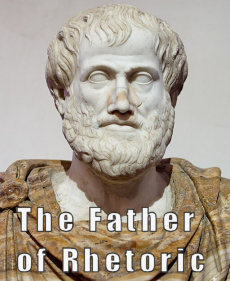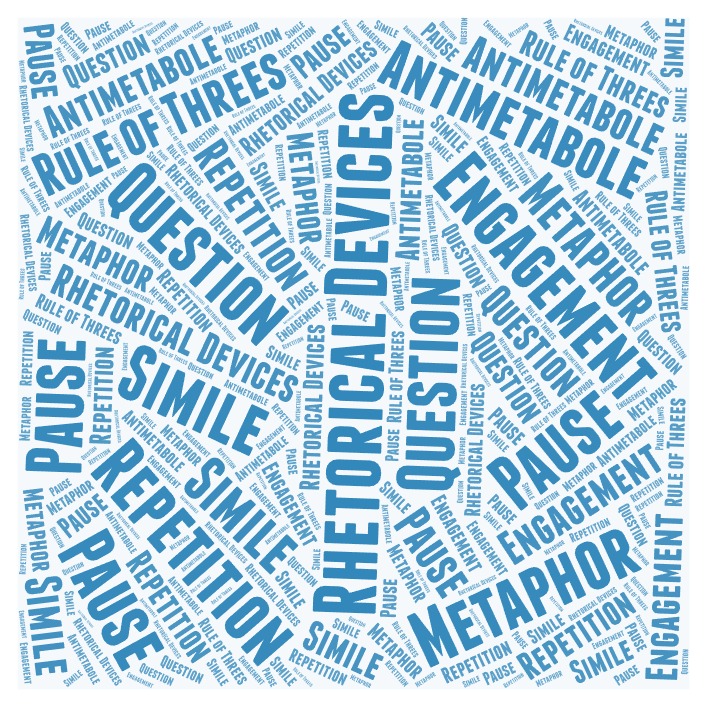Add rhetorical devices to your speech
Speeches are an art form. If you add rhetorical devices to your speech, you are like the artist who adds finishing touches to a painting. There are dozens of possibilities but here are some of my favorites. While some of these are not technically rhetorical techniques, adding specific touches to your speech will enhance your presentation and your audience's understanding.
Structure your speech using rhetorical devices for persuasion
 Marble bust of Aristotle who lived around 330 B.C. Source: Wikimedia Commons
Marble bust of Aristotle who lived around 330 B.C. Source: Wikimedia CommonsThank Aristotle for our understanding of persuasion. This third-century BC thinker was the first to proclaim that persuasion needs three elements. Centuries later most people agree. His time-tested methods of persuasion? Speak or write your appeal in a way that satisfies logos, ethos, and pathos.
Logos -- think of logic. To persuade others you must give them information that supports your point of view.
Ethos -- think of ethics. For a speaker to be convincing, that person must be trustworthy and credible to the audience.
Pathos -- think of emotion. Pathos means appealing to the heart and using arguments that inflame passions or create left-brain emotional responses.
All successful attempts at persuasion have these three elements. Watch for logos, ethos and pathos as you read commentaries or look at marketing pitches. And when you've finished writing yur script, check to see that you have covered all three elements.
Embrace the pause
Timing is everything in the speaking world. The beauty of a pause is that it focuses attention. Pauses emphasize important points. Or pauses create a change of state that causes your audience to sit up and pay attention. That's why Mark Twain famously said, No word was ever as effective as a rightly timed pause.
If you listen to professional speakers or leaders making high-stakes speeches, you'll discover that they have mastered the value of the pause. As you practice your speech, highlight the points you want to emphasize. And work in a pause to enhance the effect.
Repetition
Though not technically a rhetorical device, repetition can add punch to your speech. You started off with a central theme. Good! Repeat it at certain points and certainly at the end. A good way to use repetition is to choose a short phrase or quote and then come back to it a time or two.
In delivering one of the greatest American speeches ever, Martin Luther King used repetition dramatically when he kept telling the throngs at the Lincoln Memorial, I have a dream. That phrase conveyed passion, aspiration and hope. Similarly, Candidate Barrack Obama launched his 2008 campaign at the Democratic Convention with the trademark phrase, Yes We Can. And going full circle, he echoed his famous speech by repeating a form of that phrase in his farewell speech to the American people.
All great speakers use repetition. You should too. It's a winning technique that is easy to incorporate in your speech.
Add rhetorical devices to your speech using these techniques

Ask a rhetorical question
Why should you ask a rhetorical question?
Because it makes people think. You can ask a question of your audience that you may want them to answer. Or you may just want them to think about what you are saying.
Asking a question focuses the attention of your audience on the next point you are going to make.
Engage your audience
People's attention spans are getting shorter all the time. That's what civilizations and cell phone have done for us. So after you get into your talk, try some techniques to re-energize your audience. Here are a few suggestions:
Ask a question and call on someone. (It's best to give them advance warning.) This works because others think, Could I be next?
Make a statement or give an example of some point you are making and mention someone in the audience by name.
- It's so cold outside that even John Smith wore an overcoat.
- This machine will help you get more done than even speedy Joe Michael does when he's at his fastest.
- Betty Baker told me I'd better not go longer than 10 minutes.
Statements such as these don't have a major impact on your message but when people hear the name of one of their peers, they perk up.
Use the Rule of Threes
There's something about statements that are in sets of three. Information given in groups of threes is easier to grasp, has a lyrical rhythm, and is more memorable or humorous than other pairing of words. The Rule of Threes is a bedrock device for great orators and writers beginning with the New Testament where we hear repeatedly about the Father, Son and Holy Spirit.
Here are some other notable examples of the Rule of Threes.
- Stop, drop and roll -- what we teach kids to do if their clothes catch on fire
- Ready, set, go - launching call for a race
- The good, the bad, the ugly - a famous movie title
- Gold, Frankincense and Myrrh - the gifts of the three wise men
- Duty, Honor, Country -- Motto of the U.S. Army
- We cannot dedicate, we cannot consecrate, we cannot hallow this ground. - Lincoln's Gettysburg address
Using the rule of threes and delivering those phrases in a forceful way adds emphasis and energy to your speech.
Use metaphors or similies
Give your audience a comparison they can visualize.
A metaphor says one thing is something different. (Her smile was a ray of sunshine. The elephant in the room is a subject we won't discuss.)
A simile says one thing is like another which is really something totally different. (Her smile was like a ray of sunshine. The air in the room was like a damp blanket.)
Any polished writer or speaker will use metaphors and similes liberally to help listeners draw a mental picture that helps with understanding.
Add an antimetabole or two
The antimetabole, which is sometimes called the reversible raincoat, is one of my favorite rhetorical devices because it gives listeners an ah-ha moment. Antimetaboles are clever turns of phrases and when listeners get it, they feel somehow empowered.
An antimetabole is structured so that the last phrase is a twist on the first phrase. This can add humor or a deeper meaning. Here are some examples.
- It's not the dog in the fight, but the fight in the dog.
- It's not how old you are, but how you are old.
- If you fail to plan, you plan to fail.
- Ask not what your country can do for you; rather, ask what you can do for your country. - JFK's inaugural address.
You can easily add tweaks from this brief list of rhetorical devices and speaking techniques to make your speech more lively, engaging and memorable.